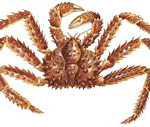
Phoca hispida
The ringed seal is the most common of the Arctic seals. It is not generally found on the open sea, but instead prefer areas where the ice is firm. It is distributed throughout the northern parts of the Baltic Sea, Canada, Alaska, Siberia and along Pacific Japanese coasts.
Adult ringed seals grow to 140-150 cm in length, with females slightly smaller than males. It is similar in shape and color to common seals, although generally darker. The belly is silver gray color and the dorsal side is pale gray with dark spots that are surrounded with pale colored rings.
The ringed seal is an opportunistic feeder, spending most of the time from late summer to early spring on this activity. It feeds mainly on benthic (bottom dwelling), nektonic (swimming) and planktonic organisms. In winter a large portion of the diet consists of Arctic cod
The female ringed seal matures reproductively at about 6 years of age and may bear one pup per year. Most mating occurs in late April and early May, which is within one month of birth. Pups can be taken from the birth lair on the ice by bears, foxes, and humans. As a result of this strong predation, the pups spend a large proportion of time in the water and learn to dive at a very young age.
Adult seals are solitary except for loose feeding aggregations in the water in summer. Starting in mid-May, they drag themselves onto the ice and bask in the sun. They moult at this time and feed infrequently. Groups of seals at haul out sites are large and seals lying on the ice are vigilant and aggressive.
Ringed seals preferred is areas that freeze to stable ice in winter. They live in darkness under ice for several months during the year. Ringed seals make lairs in the snow and ice for protection from predators and thermal shelter. They can occupy ice covered areas by maintaining breathing holes and breathing through cracks in the ice.








Social Profiles